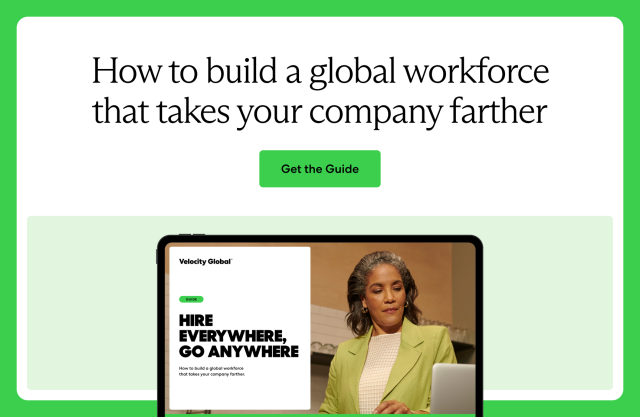Businesses looking to grow can do so in several ways: They can create a new product or service, increase their current market penetration, or enter a new market. The last option, in particular, offers several benefits, like access to new customers and increased revenue-earning potential.
However, to compliantly do business and sell products or services in a new global market, you must develop an international strategy.
This article covers what you should know about crafting an effective international strategy. We explain how to put together an action plan and what to look out for along the way.
What is an international strategy?
An international strategy is a plan that a multinational company forms when deciding how it intends to grow its business in new global markets.
For instance, businesses seeking global expansion typically start by exporting or importing goods and services abroad while they maintain headquarters in their home country. In this case, their strategy may include—but is not limited to—the following steps:
- Identify their target markets
- Create or modify a product to sell in those markets
- Determine their production and distribution methods
- Hire international staff or outsourcing partners to help facilitate the work
International strategy example
Let’s say a U.S. clothing manufacturer wants to expand into France. The clothing company has a strong foothold within U.S. retailers but wants to get its product into French department stores to boost brand awareness and revenue.
The company considers building a manufacturing headquarters in France but discovers it’s more cost-efficient in the short term to create the product in the U.S. and ship it to France. By choosing to manufacture in the U.S., the company develops an international strategy that would allow it to grow abroad while saving money and minimizing economic risk.
What are the benefits of an international strategy?
Companies that implement an international strategy to grow abroad see several benefits, from more financial stability to global brand recognition. We cover key benefits below.
Economic stability
When domestic markets are unstable, an international strategy helps companies offset economic downturns at home. For instance, if the clothing company mentioned above was hit by a recession in the U.S., it could make up for losses by an economic boon in France.
Companies with an international presence benefit from a diversified revenue stream and enjoy an economic safety net in times of downturn.
Competitive edge
Expanding abroad gives companies a competitive edge against businesses that remain domestic. Gaining international recognition gives companies access to new customers and helps develop brand awareness abroad.
Larger talent pool
Expanding internationally enables employers to tap into the worldwide talent pool and connect with candidates who have diverse skill sets, backgrounds, and salary expectations.
Companies that work with global talent also avoid potential skill and labor shortages in their home country, have greater flexibility in salary negotiations, and can align their workforce with specific business requirements.
Reduced business costs
The global marketplace provides opportunities for cost efficiency. For example, the cost of living and competitive wages may be comparatively lower in foreign markets than in a company’s domestic market, reducing overall staffing expenses.
International markets also allow businesses to access more economical sources for raw materials, advanced technological processes, and attractive tax incentives, all of which contribute to lowering their ongoing operational costs.
Innovation
Entering a new global market exposes businesses to new innovative business tools and techniques that could help streamline operations, gain a competitive edge against competitors, and ultimately improve their bottom line.
Global recognition
Businesses with a global footprint and high global fluency reach a far greater customer base and increase their brand awareness, which helps differentiate them from smaller competitors, improves their lifetime value, and decreases customer acquisition costs.
Download our guide to learn how to quickly expand your business into new markets and hire top international talent while staying compliant:

8 steps for putting together an international strategy
While every international strategy is unique, the following steps present a general guideline for businesses looking to expand globally.
1. Set goals for your international strategy
Before you do anything, take the time to understand what you want to get out of your international strategy. Every business wants to gain more customers, but your goals should be more specific than that. Consider the following questions:
- What are your sales goals for year one, year five, and beyond?
- What kind of customer retention can you realistically expect?
- How much time and money do you expect to spend on the expansion?
- How long will it take to see a return on investment?
Make sure your goals align with your product or service and your industry. Set realistic targets so you can use these goals as a benchmark for your progress.
Read also: Top 5 Global Expansion Strategies
2. Identify your product or service
While this might seem obvious, you should know what you plan to sell in the new market. If your company only has one product or service, this step should be easy. If you have numerous offerings, decide on which product or service to begin your expansion.
3. Research new markets
With your goals in hand, look for international markets where you can meet or exceed those goals. Cast your net wide by looking at several markets.
Many governments and trade associations offer resources to help you understand foreign markets. Read through their reports to learn how your product or service will resonate with the local consumer base.
While having someone pour over reports and statistics is helpful, you can’t truly understand a foreign market remotely. Consider attending trade shows in your target markets to make new contacts and learn about the local business culture. It’s possible to learn a lot about how to market your product or service when experiencing the local life and culture.
Market research also includes learning about the local regulatory environment. Every market has its own set of compliance requirements to protect workers and consumers.
4. Understand your competition
To do well internationally, you should understand the local competition and how they approach the market. Each market has its own mix of competitors and cultures that define how an industry functions. Find out which companies are thriving in each market where you plan to expand to learn what works and what doesn’t.
5. Plan your marketing strategy
Before you nail down your target markets, think about your overall marketing strategy. Consider the following questions:
- Do you want to have a different advertising message in each market you enter?
- Do you want to maintain a global brand?
- Do you want a consistent, global brand that is slightly tailored for each marketplace?
Choose whichever strategy most clearly communicates your competitive advantage to new markets.
6. Plan your international organizational structure
Entering one or more global markets affects the organizational structure within a business. Keep your staff focused on their individual responsibilities and promote efficient work with a proactive international strategy that includes organizational structure.
Also, consider your international staffing needs and how teams from different markets may communicate and work together.
7. Determine your distribution strategy
There are many ways to get your offerings to a new market. The U.S. Department of Commerce lists several channels, including the following:
- Direct to end-user
- Distributors in-country
- Your e-commerce website
- A third-party e-commerce platform
- Business franchise
Determine which channel best fits your business before entering the new market. Each one comes with its own set of advantages and disadvantages.
8. Assemble an international business strategy document
According to the U.S. Department of Commerce, only one-third of small and medium-sized businesses develop a written international business strategy before moving into new global markets. A written plan keeps your team aligned and guides your organization as it begins international expansion.
Keep your company focused on the right goals and strategies rather than simply reacting to the market.
Simplify international expansion with an employer of record
Expanding operations into an international market is challenging, but it opens the door to many new and exciting opportunities.
Partnering with an employer of record (EOR) can help your company achieve healthy international growth quickly and cost-effectively—without the legal headaches.
Whether you want to swiftly enter new markets without foreign entity establishment or need a quick and compliant solution for hiring international employees during foreign entity setup, an EOR can help every step of the way.
Contact Velocity Global to learn how we can simplify global expansion for your organization.
Disclaimer: The intent of this document is solely to provide general and preliminary information for private use. Do not rely on it as an alternative to legal, financial, taxation, or accountancy advice from an appropriately qualified professional. © 2023 Velocity Global, LLC. All rights reserved.



